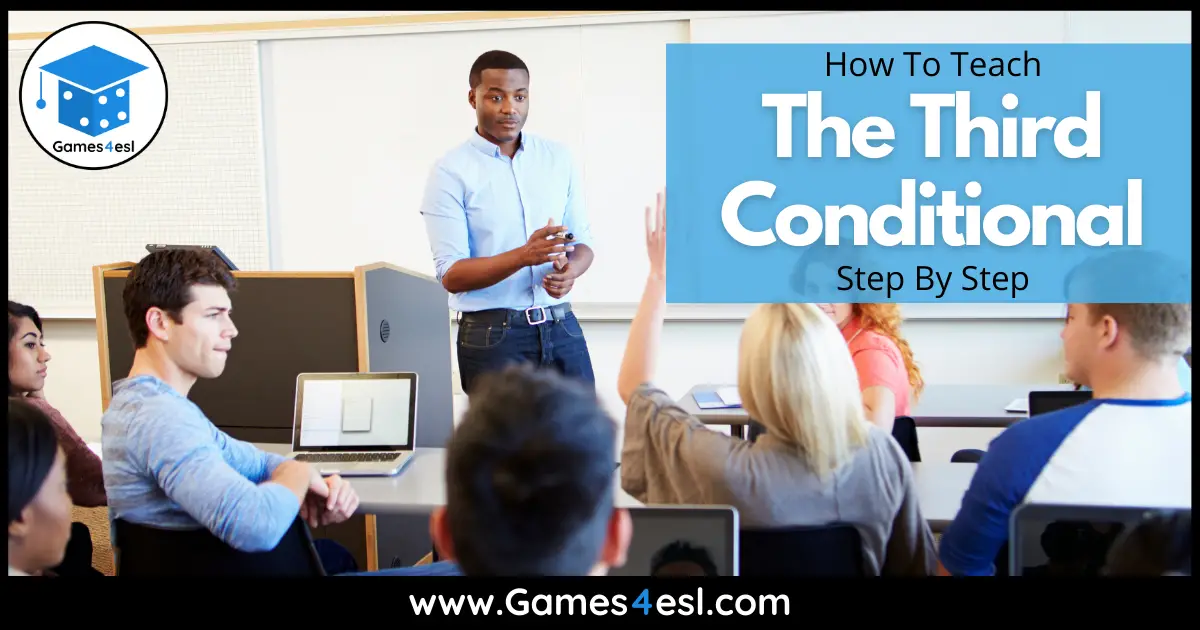How To Teach The Third Conditional Step By Step
The 3rd conditional form is undoubtedly the most difficult of the conditional tenses for students to learn. However, with this guide on how to teach the third conditional form, and a little patience, your students will be using this grammar structure in no time.
It’s best to teach the third conditional one step at a time, and you’ll probably need a minimum of two classes to teach it effectively. Once students understand the third conditional form, they’ll be able to use it to talk about a past event that didn’t happen and to imagine what the consequence of that event would have been had it actually happened. As you can see, it is a difficult concept to grasp, even for teachers. So, the first step to teaching the third conditional form is to explain this concept.
Related: Third Conditional Example Sentences And Questions
How To Teach The Third Conditional Form
Step 1: Explain The Concept
The very first step is absolutely crucial. Your students need to understand what this two-part, multi-verb phrase is actually saying. The best way to help students understand what third conditional sentences are is by introducing this form to them using a natural conversation.
To introduce the topic to your students, start asking them about significant events that happened in their lives. It can be political or news-worthy events or even just more local, relatable situations. Ask them how these events have affected their lives.
As you start talking about these events, you’ll be able to practice the past simple and the past participle, which is another advantage to introducing the topic this way. After your students have told you some examples, ask them the question:
“How would your life have been different if that hadn’t happened?”
You can then help them respond to this question by writing a third conditional sentence structure on the board:
“If that hadn’t happened, I would have …”
Once you have asked and your students have answered, you can write some of these example sentences on the board. The next step then would be to highlight that the sentences they made are referring to a hypothetical situation in the past that didn’t happen and that they are stating what they would have done had the situation actually happened.
At this stage, students may still be a little confused, and that’s okay. Be sure to do many comprehension check questions and if necessary, provide lots of third conditional example sentences.
Step 2: Explain How To Form The Third Conditional
Now that your students are starting to grasp the concept, it’s time to show them the structure. When teaching the third conditional form, it’s a good idea to stay a bit formulaic at first and try to use simple examples and language. Here’s an example of how you could explain how to form the third conditional that you could adapt for your lesson:
Part A is the event that did not occur, formed by “if + had + past perfect”. Then, part B is the imaginary result formed by “Would / Wouldn’t + have + past perfect”. For example:
“If it had been cheaper (part A), then I would have bought it (part B).”
Next, after showing students a few examples, show them that you can also change the order of the sentence so that Part B is first followed by Part A, and it carries the same meaning.
Step 3: Re-Write Exercise
Like learning any new grammar structure, practice makes perfect. A great way to practice forming third conditional sentences and questions is the following exercise. Provide students with many example sentences. You can find and print a list of third conditional example sentences here.
Next, ask students to re-write these sentences the opposite way round. So, if the example sentence has Part A first followed by Part B, have them write the sentence with Part B first followed by Part A. This exercise is a great way to get students practicing and thinking about the structure of third conditional sentences. You can also ask students to turn the sentences into questions, too.
Step 4: Conversation Practice
Next, it’s time to have students practice talking using the third conditional form. Divide the students into groups. Assign each group a different event that happened in the past (historical/political/personal, etc). Then, have each group discuss with each other what they would have done to change the past if they had been there.
Step 5: Address Common Mistakes And Review
During the speaking activity, you can walk around the class and listen out for some common mistakes that students often make. Take note of these mistakes and address them at the end of the class as you review the lesson.
To review the class, be sure to go over the concept and what third conditional sentences are used for, how to form third conditional sentences and questions, and the different forms that these can take.
Thanks for reading. I hope you found this guide useful. Before you go, be sure to check out these related resources:

